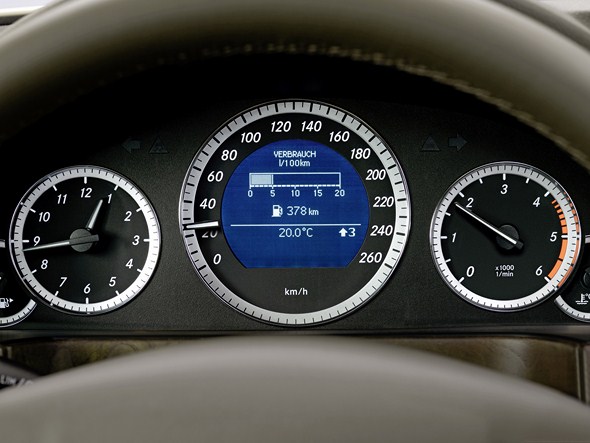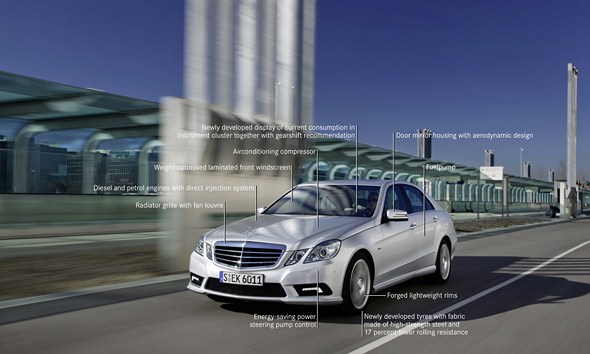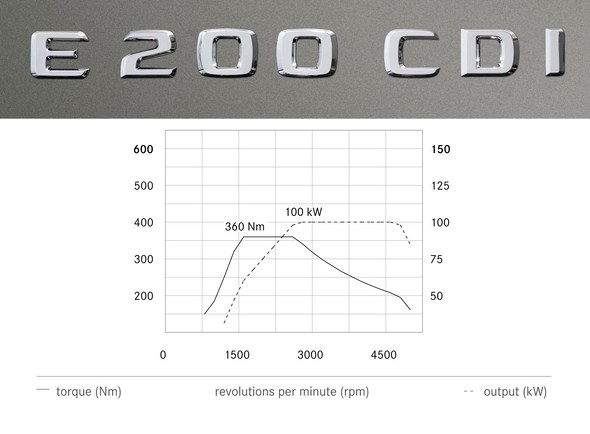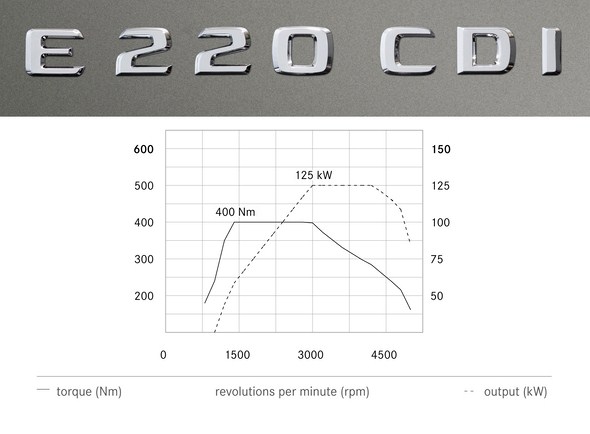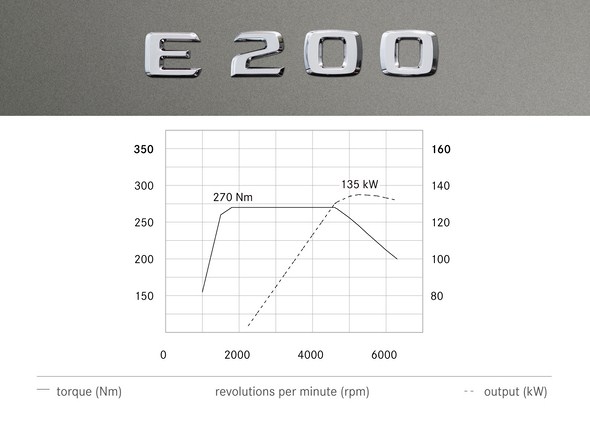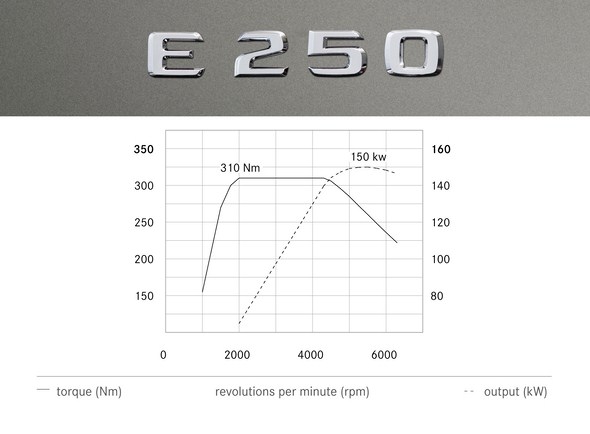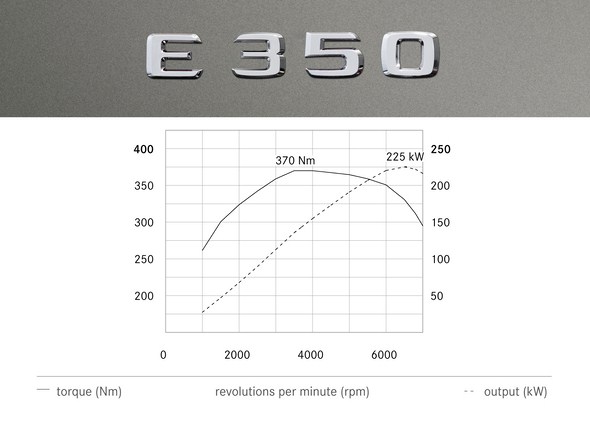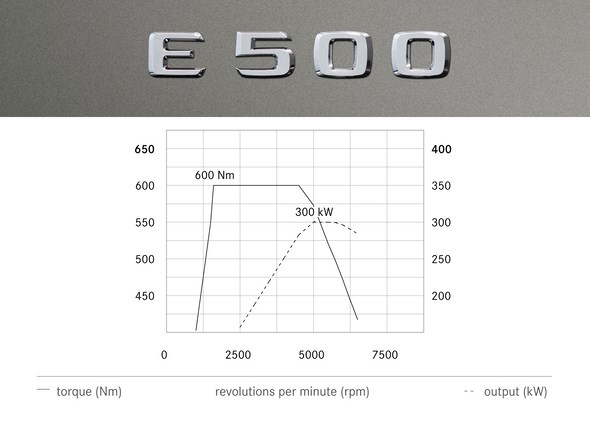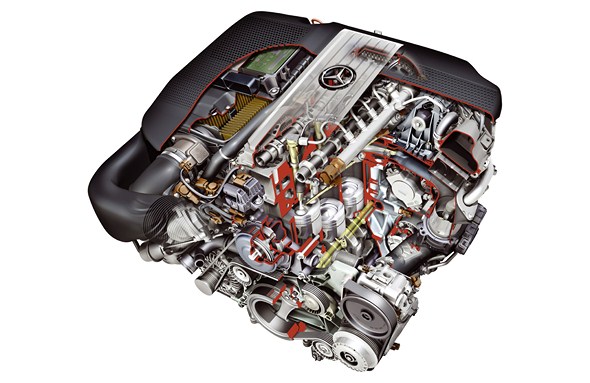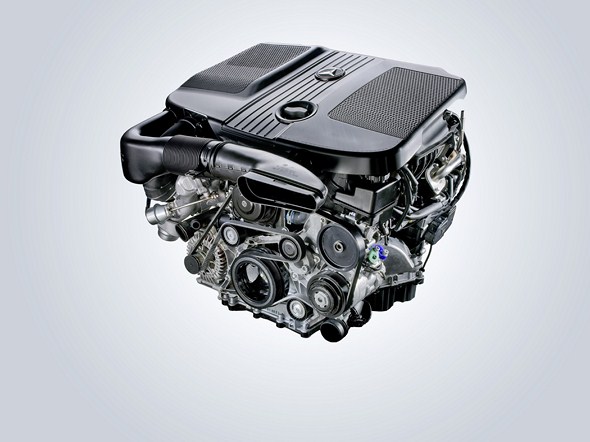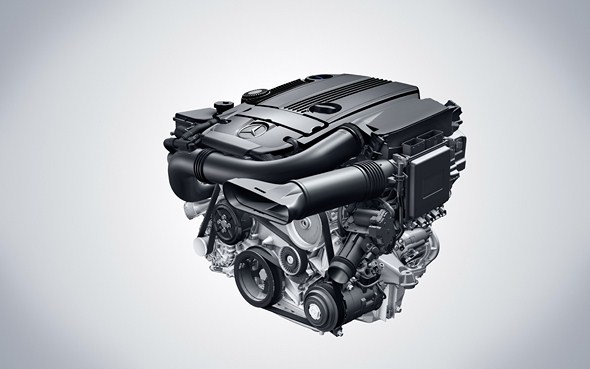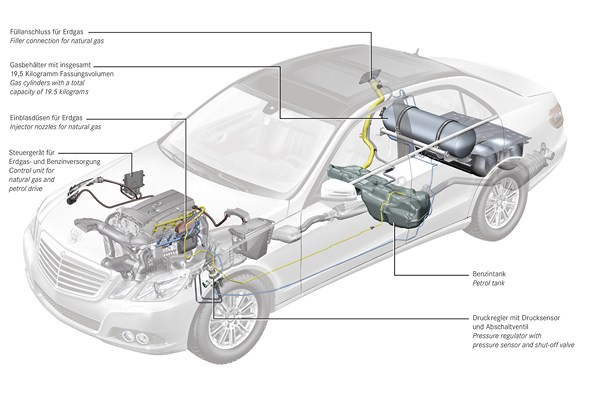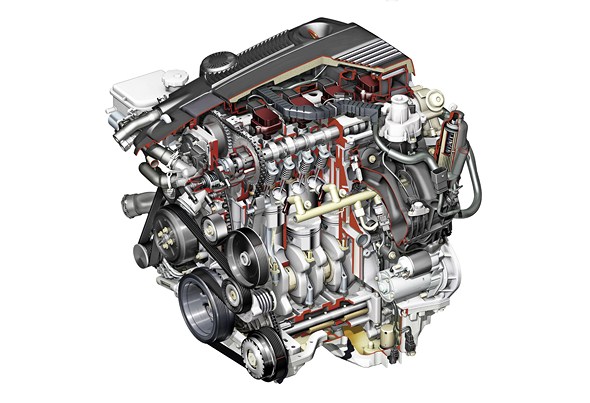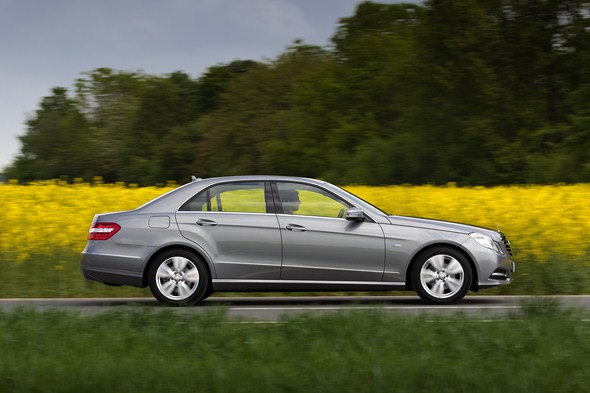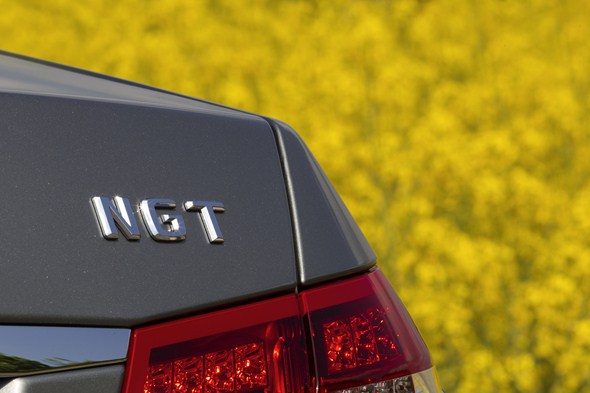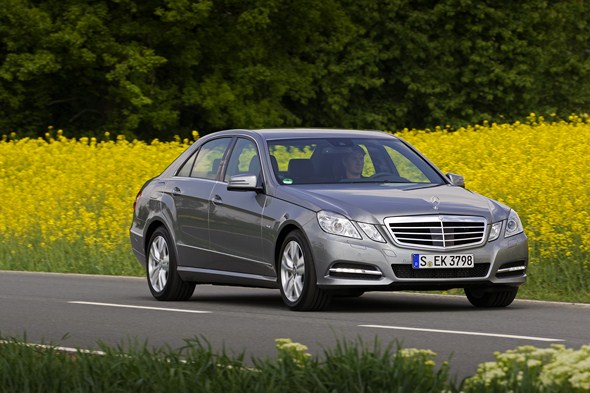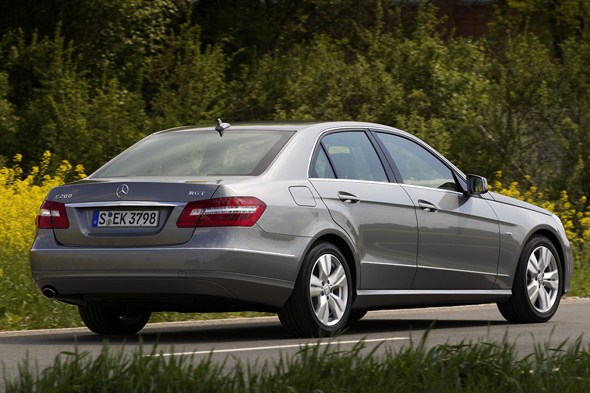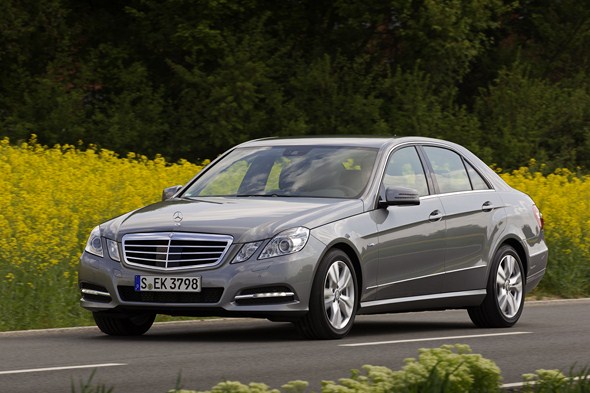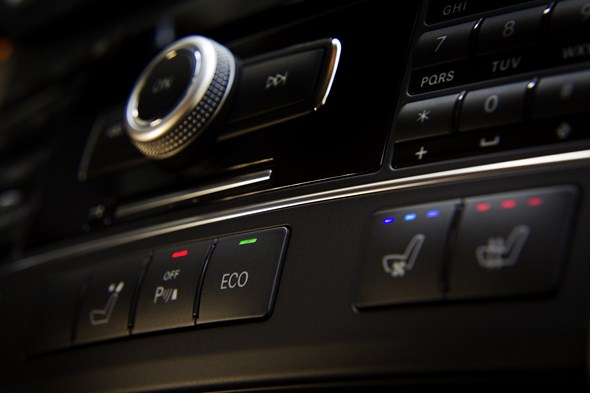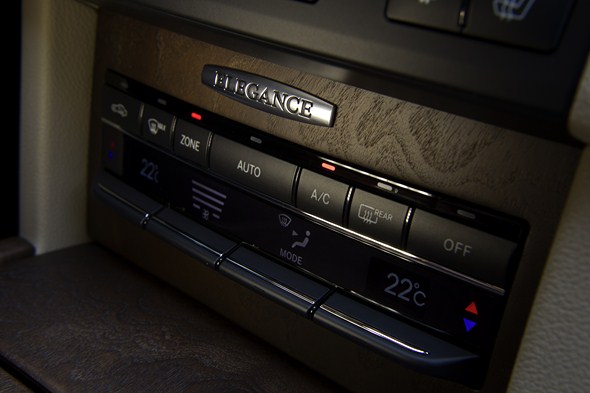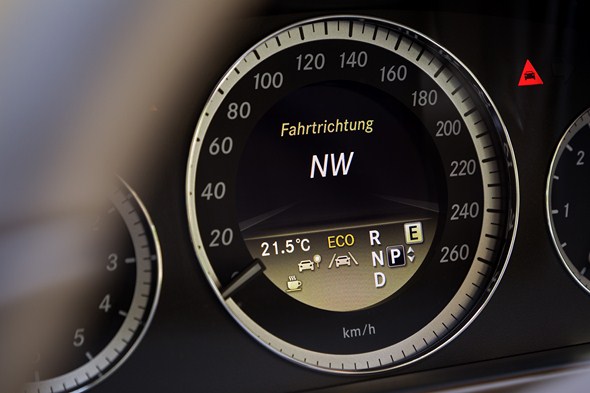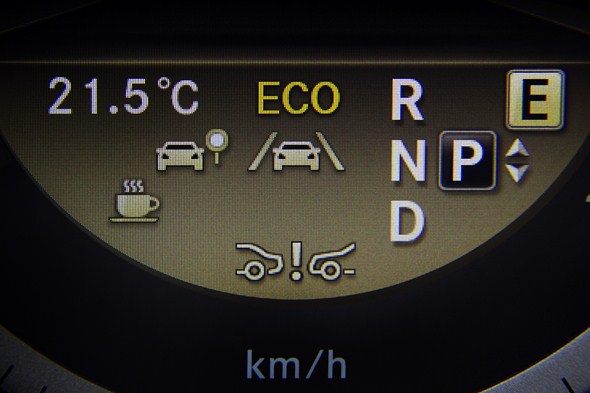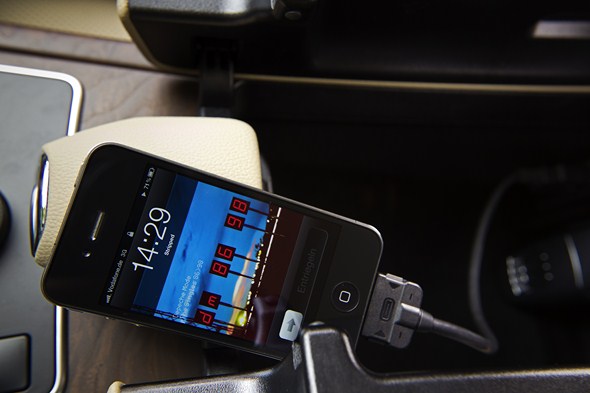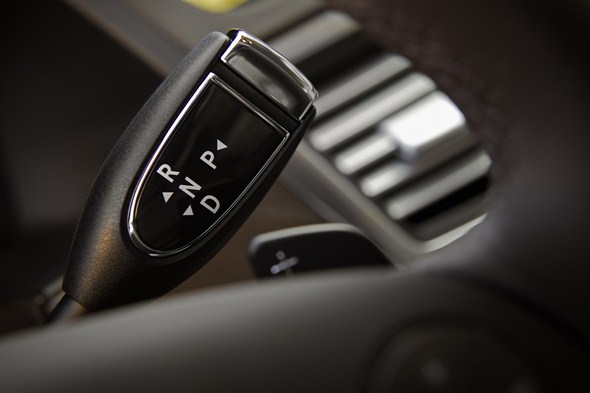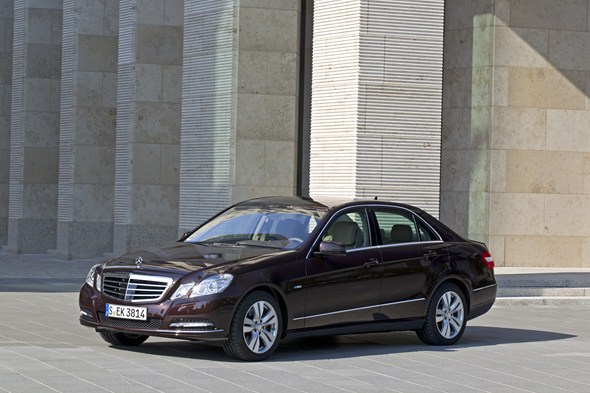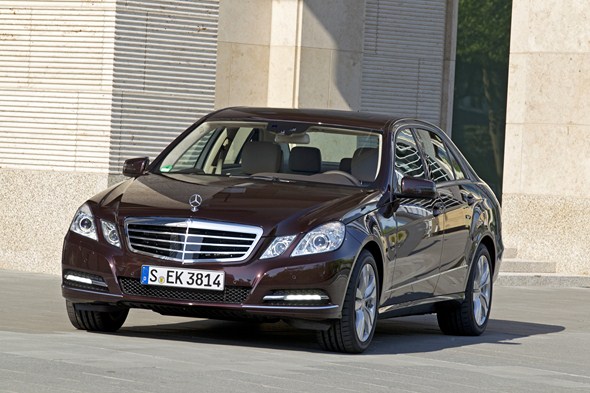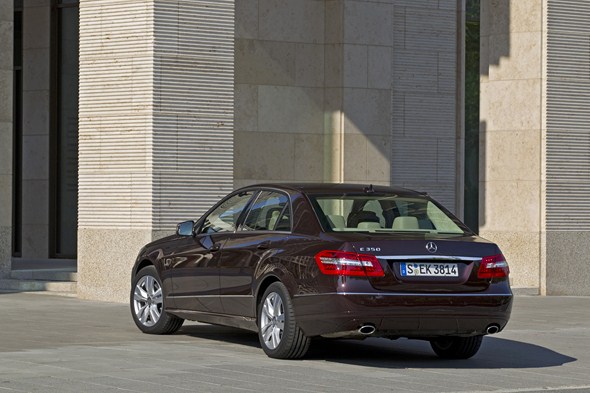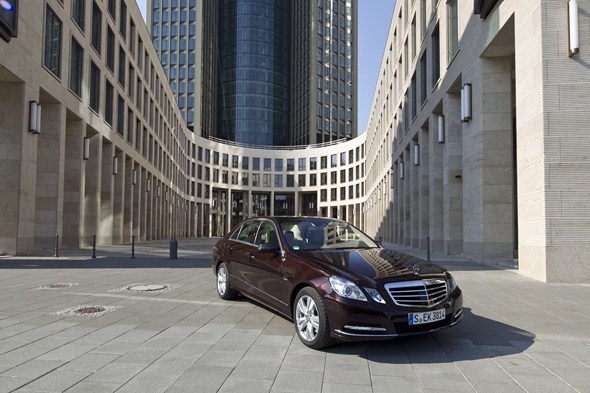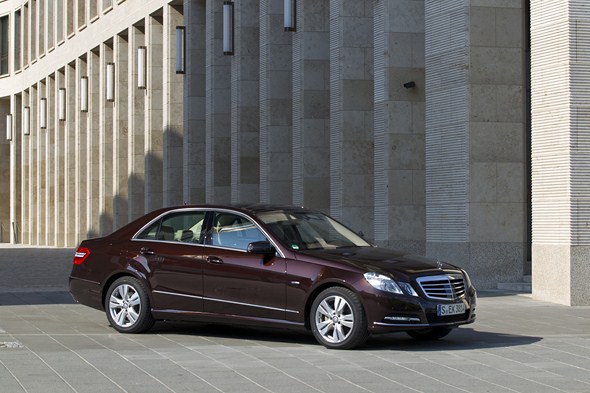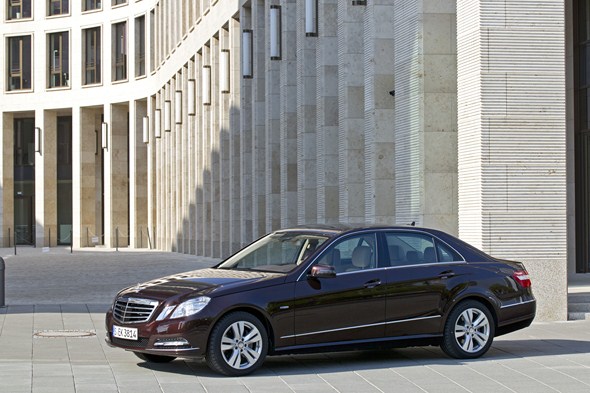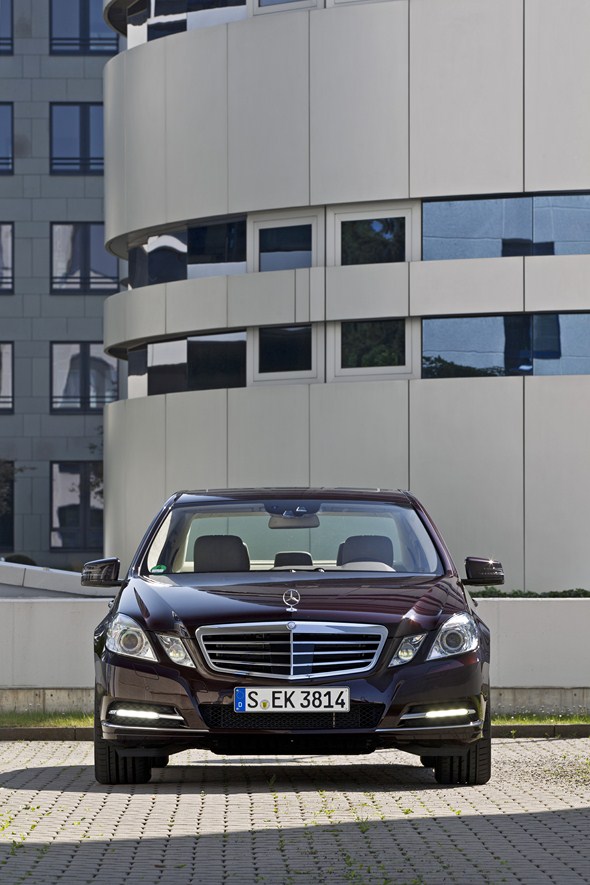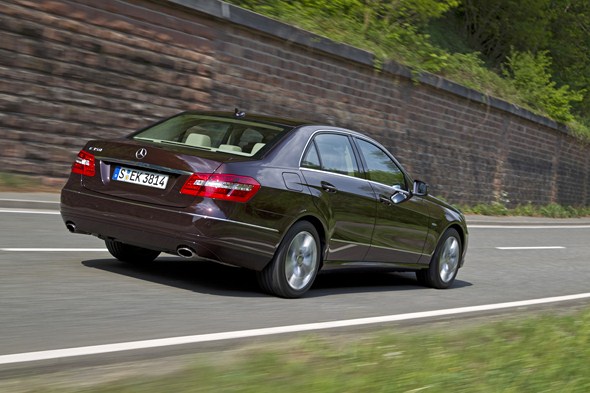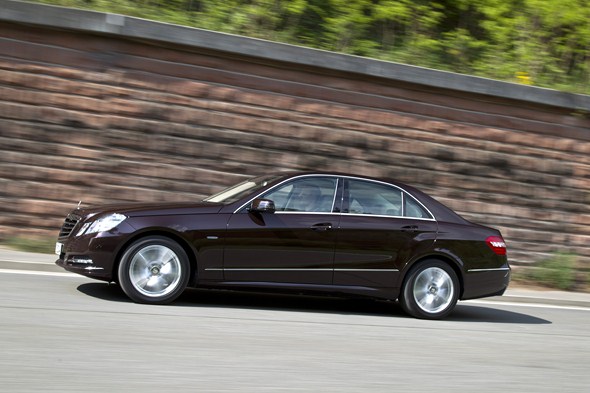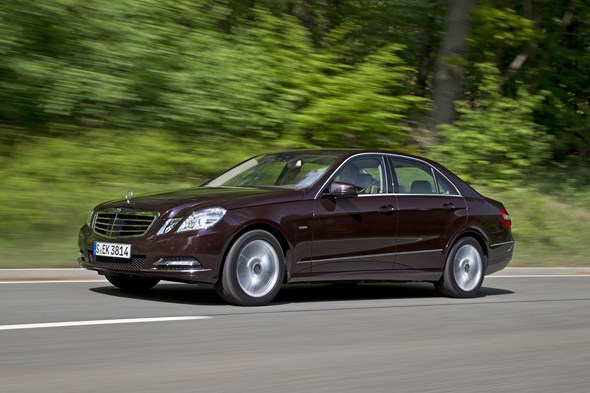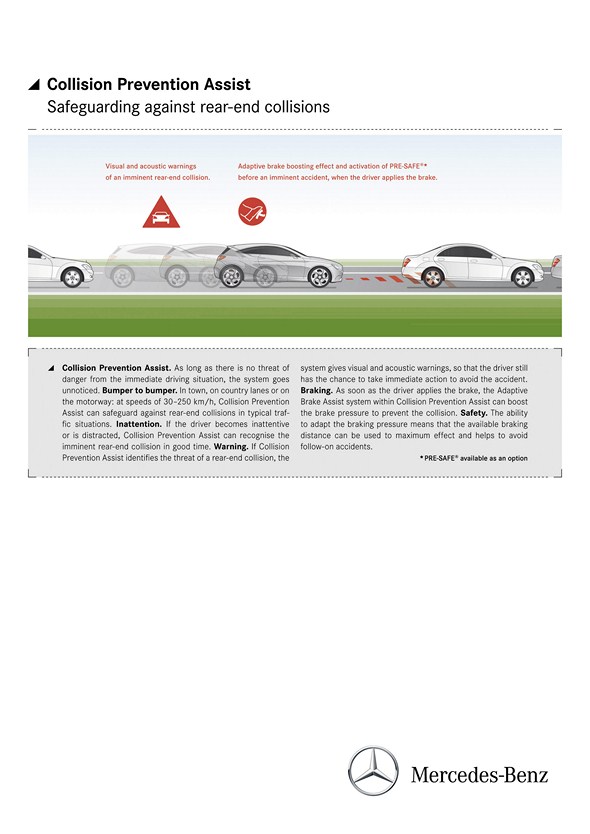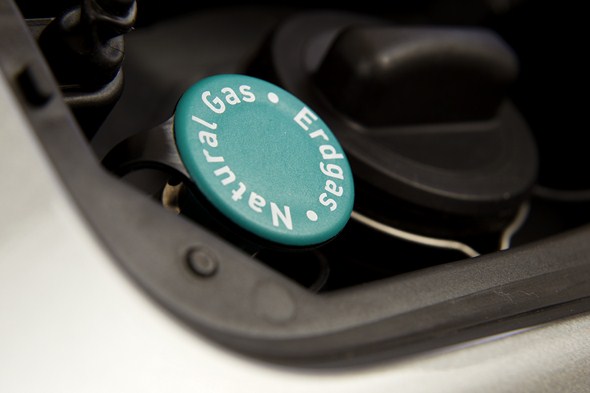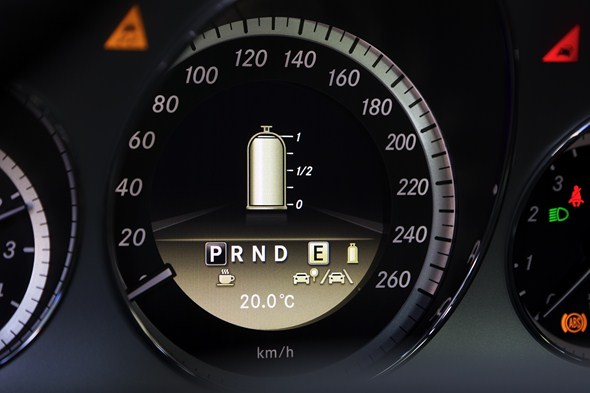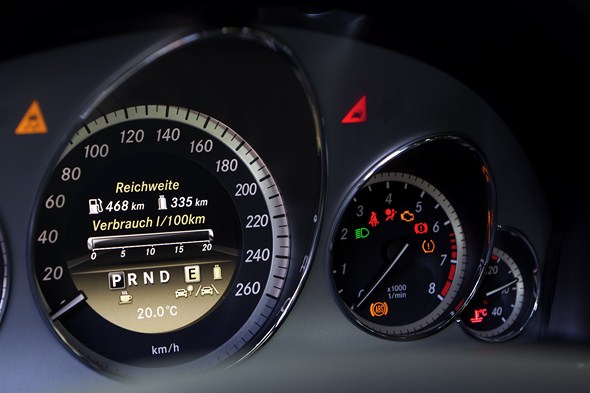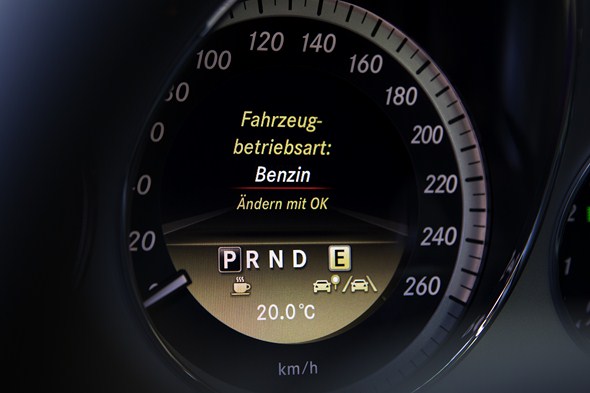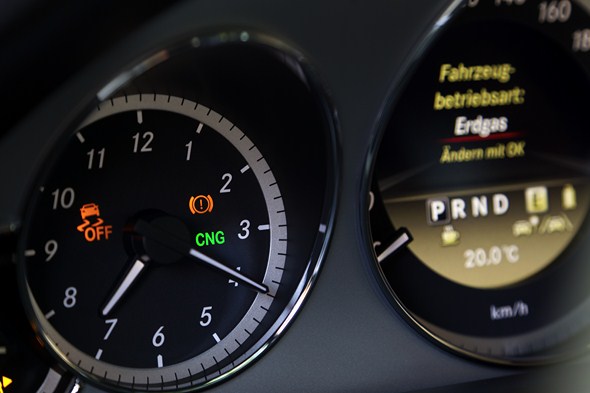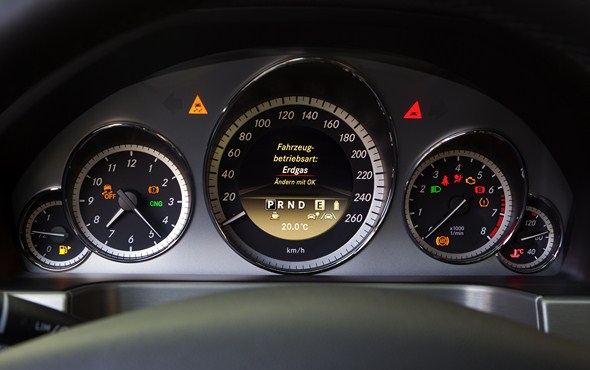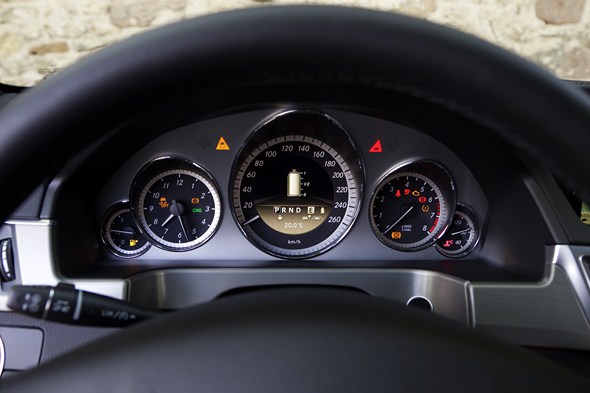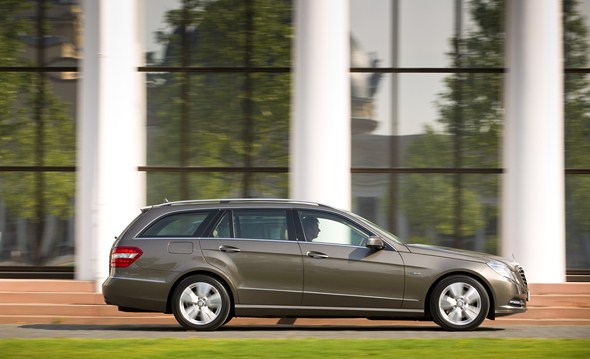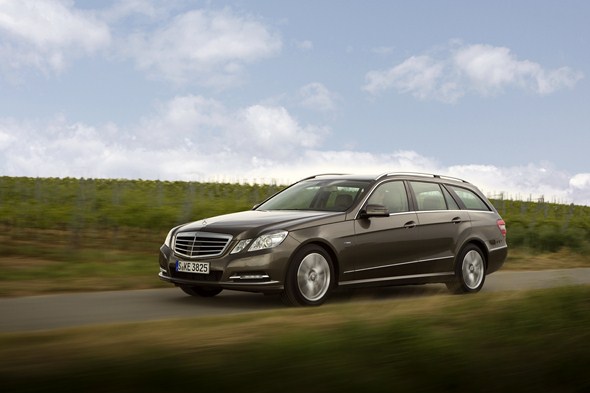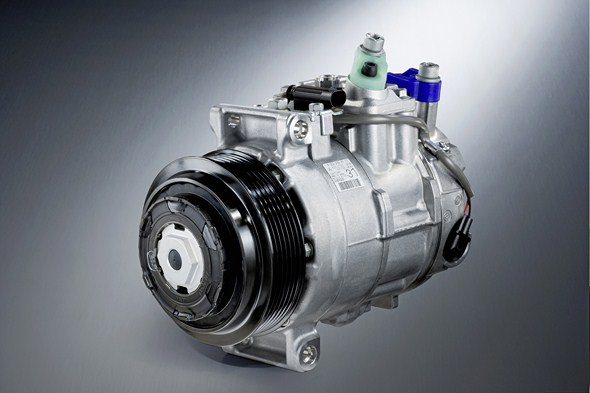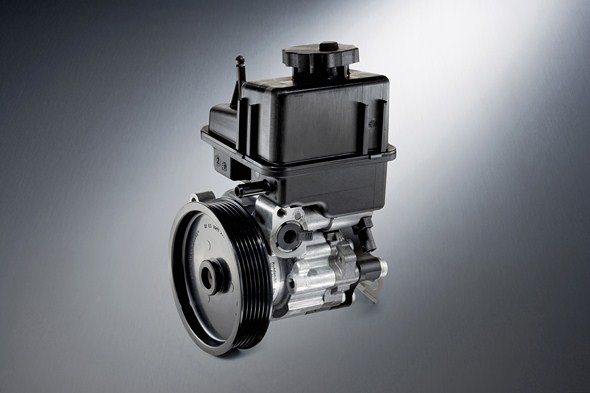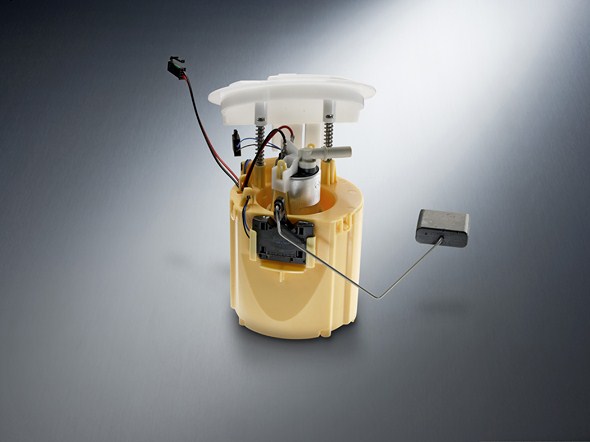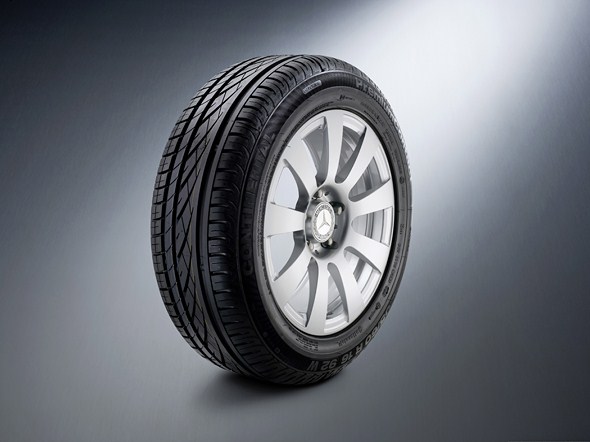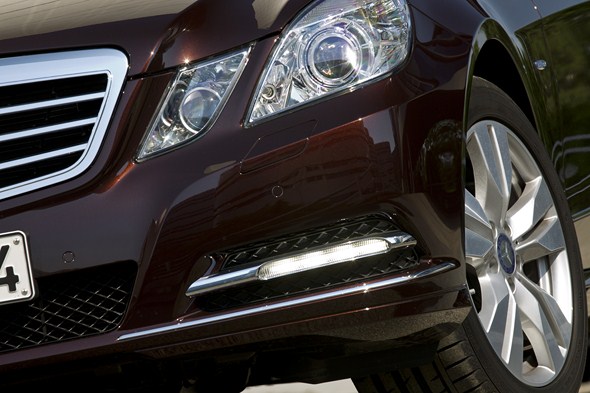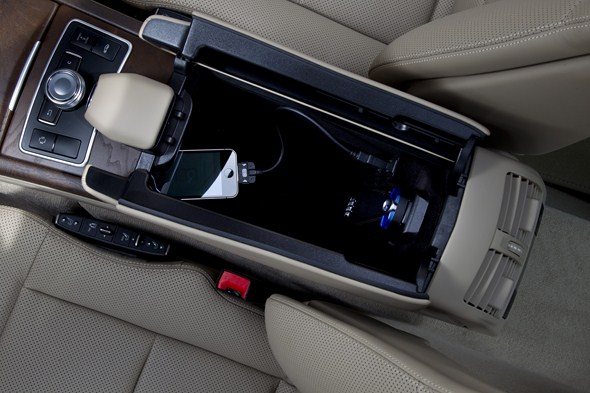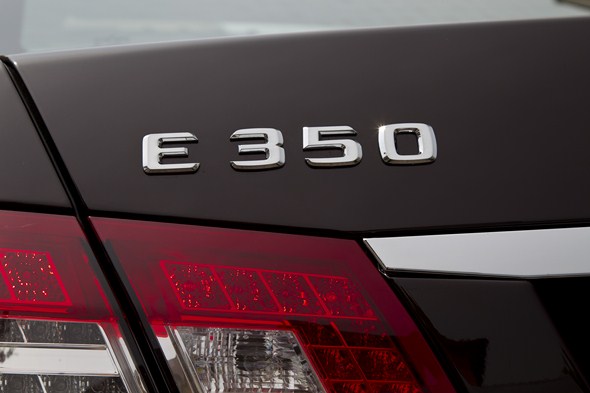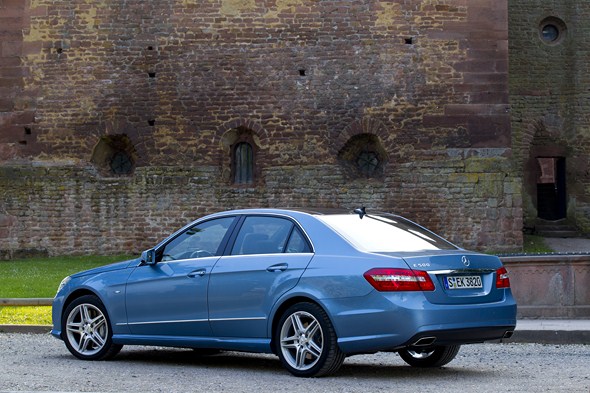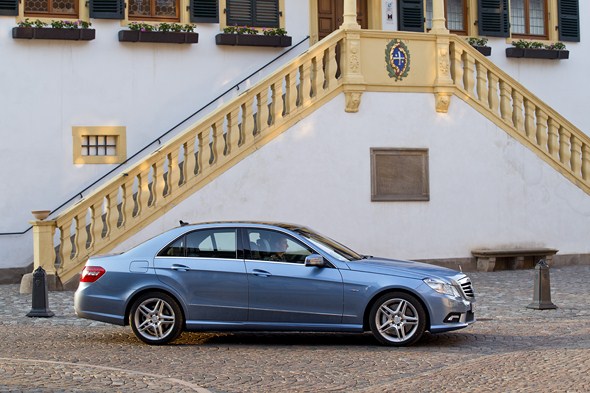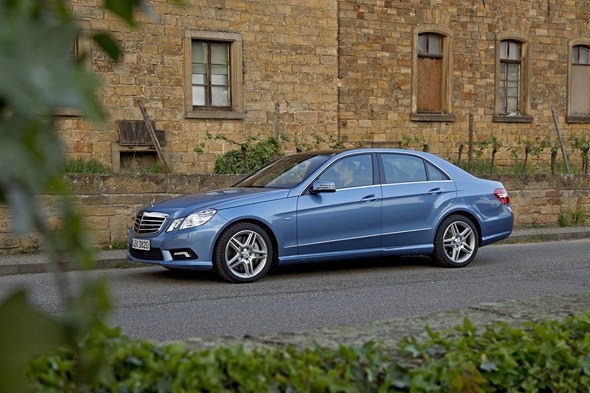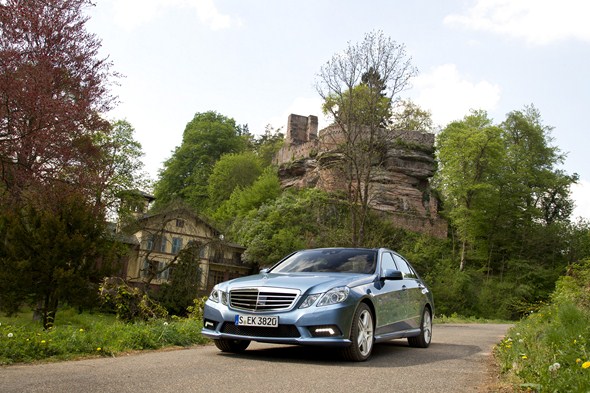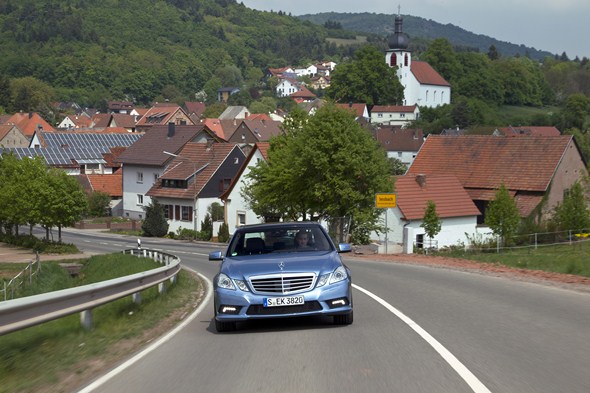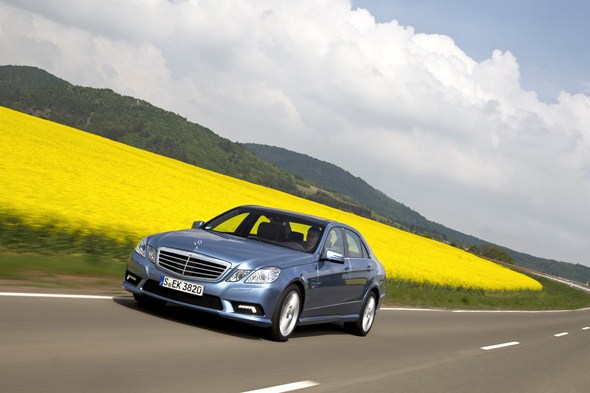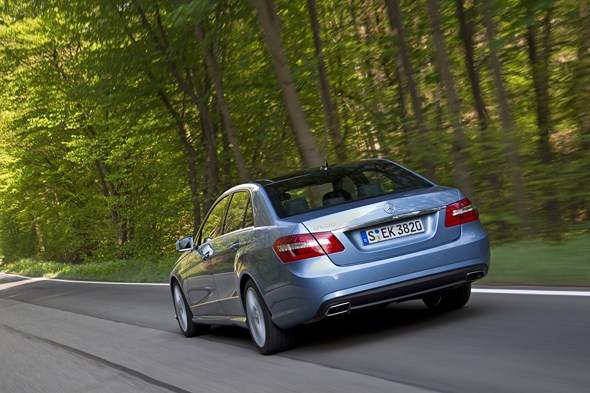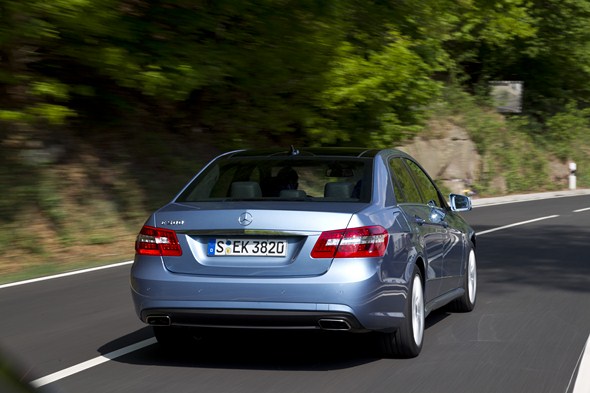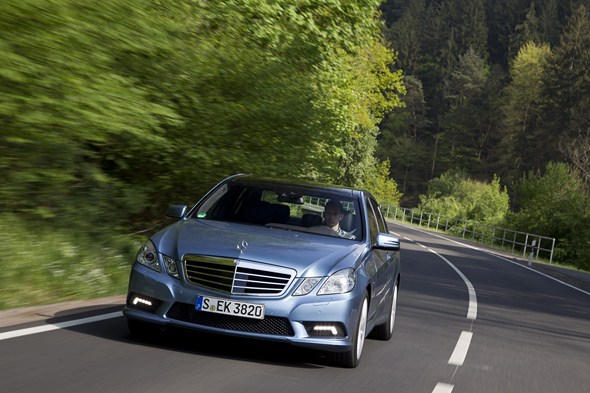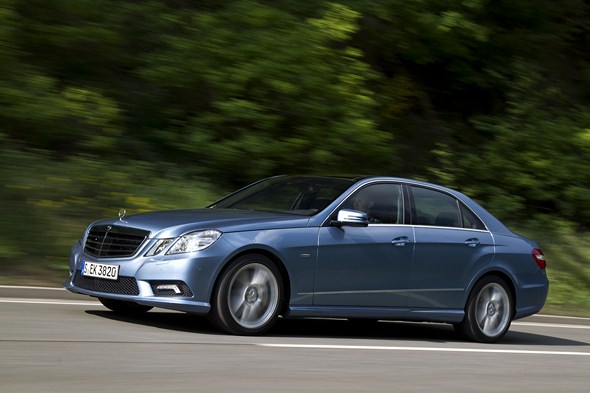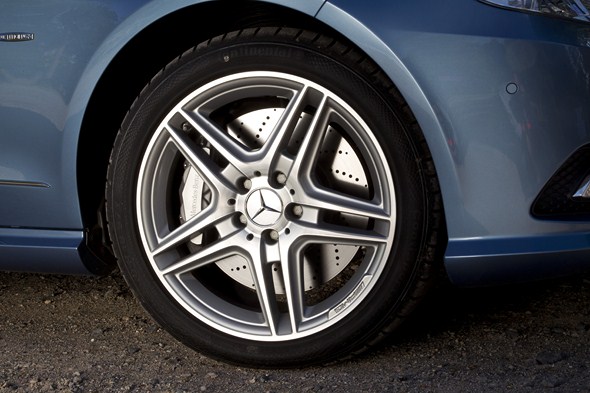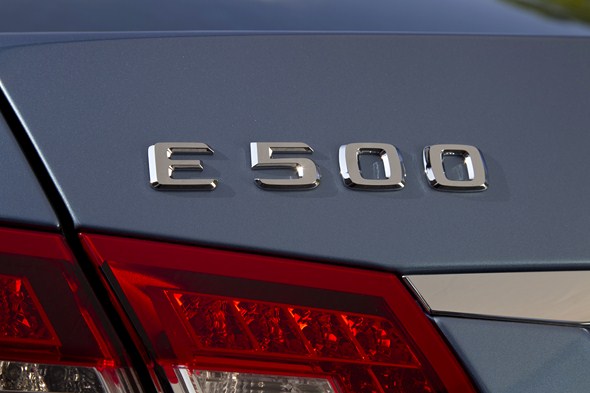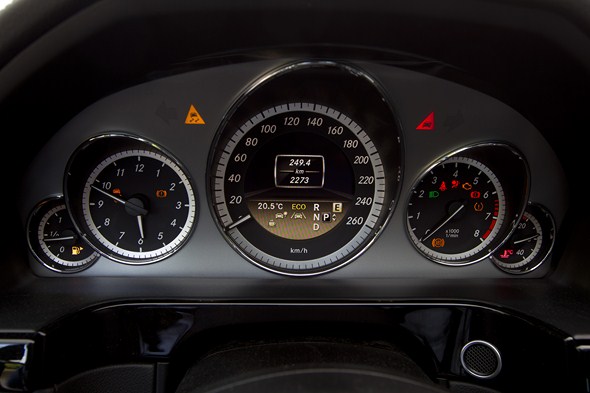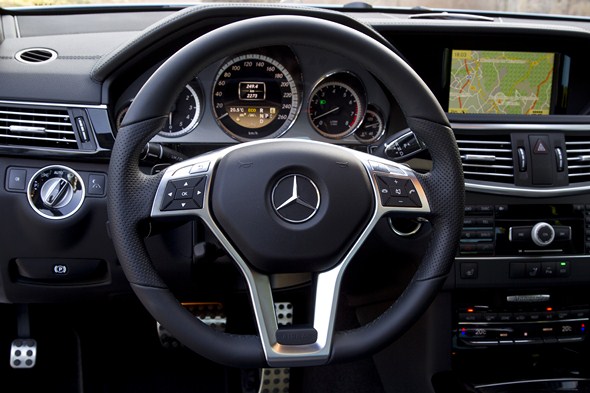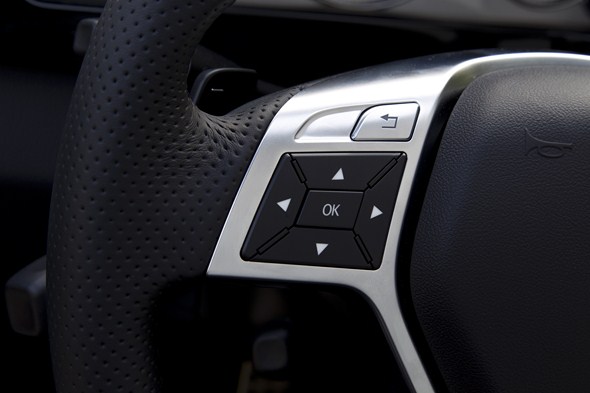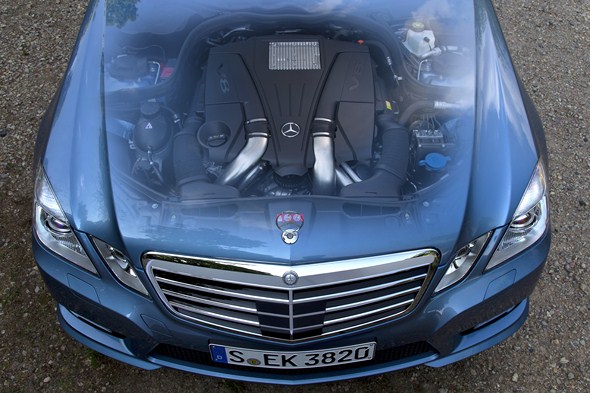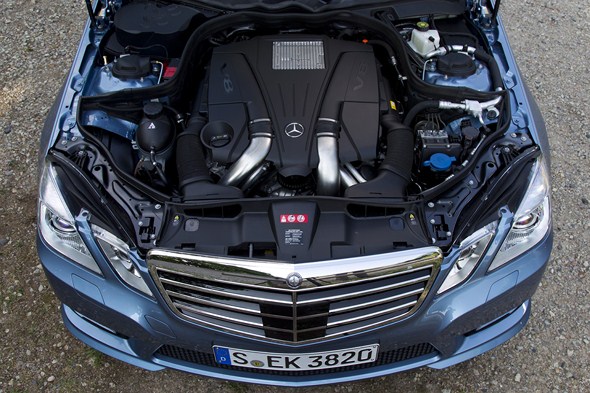New engines for the E-Class

E-Class more efficient than ever
With V6 and V8 petrol engines that consume up to 20 percent less fuel, Mercedes-Benz is once again raising the measuring standard for efficiency in the E-Class segment. For example the E 350 BlueEFFICIENCY with a V6 engine has a low NEDC consumption of 6.8-7.0 litres of premium petrol per 100 kilometres. This corresponds to CO2‑emissions of 159-164 g/km. The combined consumption of the new V8 model E 500 BlueEFFICIENCY has fallen by 17 percent to 8.9 l/100 km (209 g/km CO2)*. All** petrol and diesel engines in the E-Class now have direct injection. The leap in efficiency achieved with the BlueDIRECT engines is supported by the ECO start/stop function, which is also standard equipment for the four-cylinder models in future. In addition all automatic versions** are equipped with the improved 7G-TRONIC PLUS 7-speed automatic transmission, which likewise contributes to fuel economy.

“The new BlueDIRECT V6 and V8 engines set previously unattained standards in the luxury class,” says Dr. Thomas Weber, the member of the Daimler AG Executive Board responsible for corporate research and development at Mercedes-Benz Cars. “With the new V6 engine in the E 350 BlueEFFICIENCY we are able to realise fuel consumption figures previously only possible for four-cylinder units.
To remain at the very peak in the automotive executive class, however, Mercedes-Benz is not restricting itself to the introduction of highly efficient engines, but also using every conceivable means of saving fuel – from aerodynamics to lightweight construction, and from optimised transmissions right up to the electrification of the powertrain and peripheral units.”
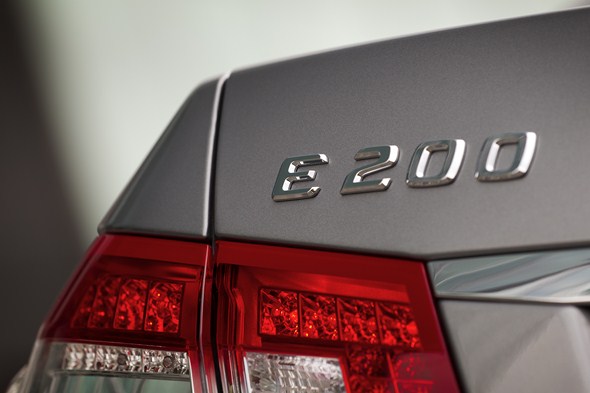
BlueDIRECT: the most efficient form of direct petrol injection
The two BlueDIRECT petrol engines in the E 350 BlueEFFICIENCY and E 500 BlueEFFICIENCY represent the new generation of V6 and V8 engines, which celebrated its world premiere in the S-Class and in the CL. The centrepiece of the BlueDIRECT technology package is third-generation direct petrol injection with spray-guided combustion and an injection pressure of 200 bar.
Major features:
- the Multi-Spark Ignition (MSI) system, which enables up to four sparks to be triggered in rapid succession within one millisecond
- latest-generation piezo injectors for up to five injections per power stroke
- stratified combustion is extended with a newly developed lean-burn process (“Homogeneous Stratified”), which greatly widens the characteristic map for fuel-efficient lean-burn combustion in the V6 engine. The first fuel spray is injected on the intake stroke, whereupon a homogeneous basic mixture is formed. The actual “stratified” injection takes place on the compression stroke prior to ignition, and is map-dependently controlled in the form of a single or double injection.
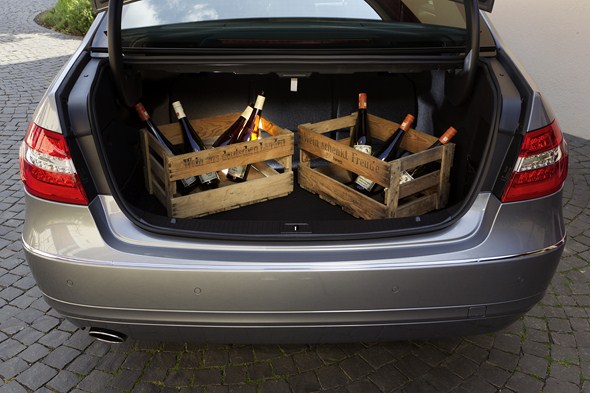
E 350 BlueEFFICIENCY: the most fuel-efficient petrol model in its class
The 3.5-litre V6 engine of the E 350 BlueEFFICIENCY is naturally aspirated. As a major distinction from the preceding engine, the V-angle between the cylinder banks has been reduced from 90 degrees to 60 degrees. This has enabled the balancer shaft compensating primary vibrations to be omitted. As a result the driver notices an outstanding level of comfort.
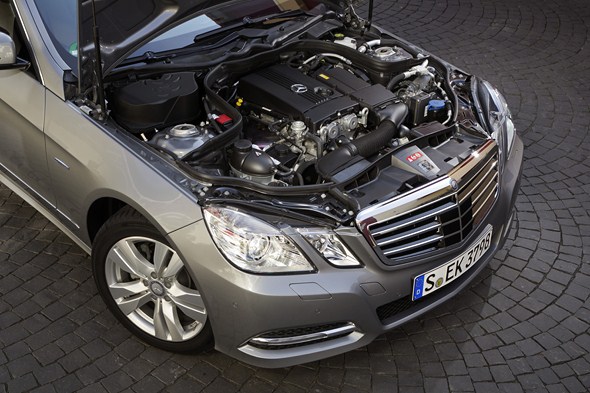
Another feature is the completely new air intake system with a variable-resonance intake manifold. The wealth of innovations has a positive effect on both performance and fuel consumption: with the same displacement, the output of the E 350 BlueEFFICIENCY has increased from 215 kW (292 hp) to 225 kW (306 hp), with maximum torque increased to 370 newton metres (previously 365 Nm) and available over a wide engine speed range from 3500 to 5250 rpm.
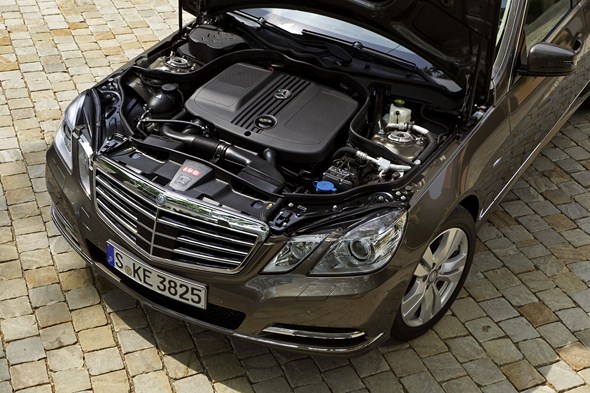
At the same time Mercedes engineers have achieved a remarkable reduction in fuel consumption. The NEDC consumption of the preceding model (8.5 litres of premium petrol per 100 kilometres) has been reduced by one fifth.
The new V6 petrol engine of the E 350 BlueEFFICIENCY consumes only 6.8-7.0 l/100 km (E 350 4MATIC BlueEFFICIENCY: 7.4-7.5 l/100km)*. This corresponds to a saving of 1.7 litres or 20 percent, and makes the E 350 BlueEFFICIENCY the most fuel-efficient petrol model in its performance class. CO2 emissions have likewise fallen by 20 percent, from 199 to 159-164 g/km (E 350 4MATIC BlueEFFICIENCY: 174-176 g CO2/km)*.
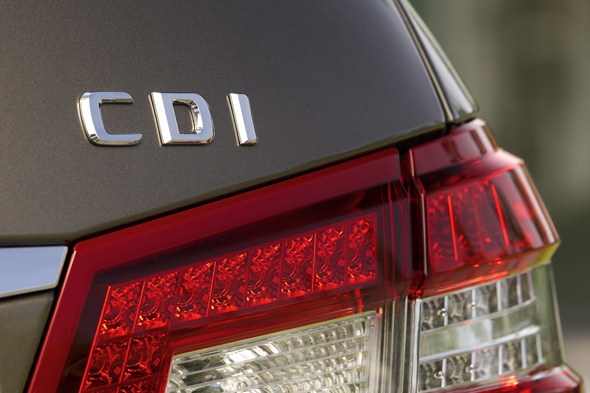
The E 350 BlueEFFICIENCY combines its excellent fuel economy with dynamic performance. Acceleration from zero to 100 km/h takes just 6.3 seconds (E 350 4MATIC BlueEFFICIENCY: 6.6 s)*. Maximum speed is 250 km/h (electronically limited).
E 500 BlueEFFICIENCY: more power with far lower fuel consumption
While the V6 engine is a naturally aspirated unit, the new V8 engine of the E 500 BlueEFFICIENCY for the first time features twin turbocharging, which was previously only familiar from the 12-cylinder S-Class and CL. Despite a significantly smaller displacement (4633 cc, previously 5461 cc), the eight-cylinder has gained in both output (300 kW/408 hp, previously 285 kW/388 hp) and torque (600 Nm, previously 530 Nm).
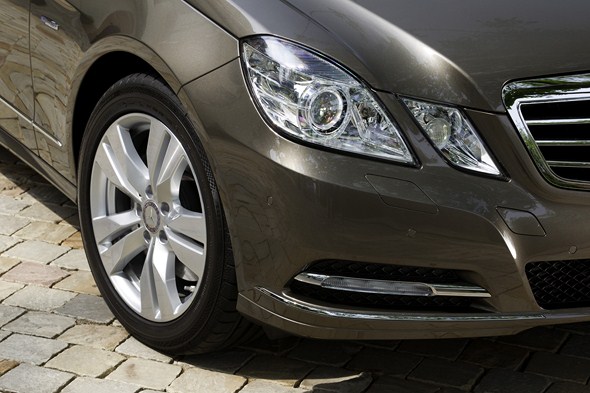
At the same time fuel consumption has fallen by around 17 percent, from 10.8 to 8.9 l/100 kilometres (E 500 4MATIC BlueEFFICIENCY:
9.4 l/100km)*. CO2-emissions have fallen to the same extent, from 253 to 209 g/km (E 500 4MATIC BlueEFFICIENCY: 219 g/km)*. These figures make the new E 500 BlueEFFICIENCY the executive saloon with the lowest fuel consumption in its performance class.
The excellent efficiency goes hand in hand with superior performance: the E 500 BlueEFFICENCY and the E 500 4MATIC BlueEFFICIENCY sprint from zero to 100 km/h in 5.2 seconds. Top speed is 250 km/h (electronically limited).
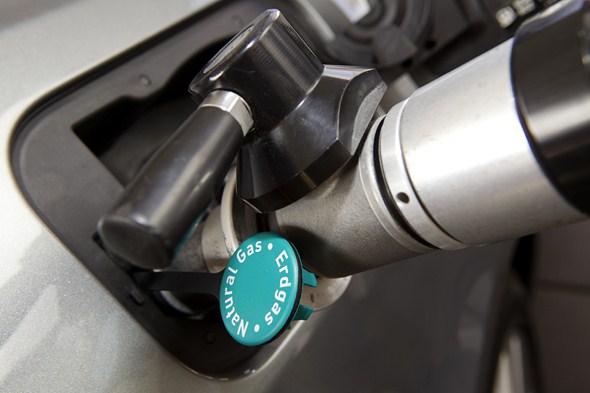
Both the new V6 and the new V8 from Mercedes-Benz have aluminium crankcases, pistons and cylinder heads. The crankshaft, connecting rods and valves are of special forged steel. Thanks to systematic lightweight design
and intensive fine-tuning of details, engine friction has also been reduced by 28 percent compared to the previous engine.
The E 350 BlueEFFICIENCY and E 500 BlueEFFICIENCY at a glance*
| E 350 BlueEFFICIENCY | E 500 BlueEFFICIENCY | |
| Engine/cylinders | Petrol/V6 | Petrol/V8 |
| Standard transmission | 7-speed automatic | 7-speed automatic |
| Displacement | 3498 cc | 4633 cc |
| Rated output | 225 kW/306 hp | 300 kW/408 hp |
| Rated torque | 370 Nm at 3500-5250 | 600 Nm at 1600-4750 |
| Fuel consumption of 2011 E-Class** | 6.8-7.0 l/100 km | 8.9 l/100 km**** |
| Fuel consumption of preceding model** | 8.5-8.8 l/100 km | 10.8-11.2 l/100 km |
| CO2 emissions of 2011 E-Class*** | 159-164 g/km | 209 g/km**** |
| CO2 emissions of preceding model*** | 199-205 g/km | 253-261 g/km |
*figures for Saloon; **NEDC combined fuel consumption; ***NEDC ****provisional figures
BlueEFFICIENCY: package of measures for efficient environmental protection
As part of the standard BlueEFFICIENCY package designed to improve efficiency, the engineers also reduced the energy consumption of major ancillary units in all E-Class petrol and diesel models. The luxury saloon therefore has a demand-controlled oil pump operating with two pressure stages. At low engine speeds and loads the pump operates at a low pressure. The high pressure level is only activated at high loads and engine speeds. Especially in urban traffic, this means that the lubrication and cooling points of the engine can be supplied for far less output.
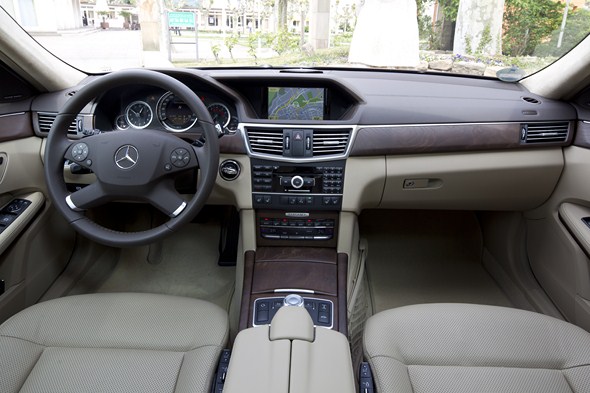
As another special feature of the BlueEFFICIENCY models, the demand-controlled water pump is only activated when the best possible operating temperature has been reached, thereby achieving a faster warm-up and likewise helping to save fuel. There is also energy-saving control of the fuel pump, air conditioning compressor and power steering.
Each time the car is braked, kinetic energy is converted into heat and therefore goes to waste. This is why the E-Class incorporates efficient alternator management. This means that, whenever the engine is coasting and whenever the vehicle is braked, the voltage level in the vehicle electrical system is increased and the battery is charged.
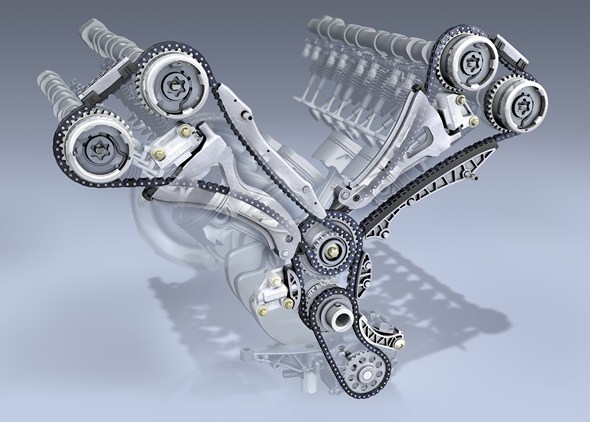
This increased alternator load assists the driver with braking and also helps to recuperate part of the braking energy, which is converted into electrical energy. This is why the experts refer to recuperation. Conversely, the alternator switches to no-load operation in certain situations – for example when accelerating or when the battery charge level is high – thus relieving the strain on the drive system.
The BlueEFFICIENCY concept for the E-Class also includes aerodynamic improvements using an automatically controlled fan louver, which regulates the airflow into the engine compartment as required.
ECO start/stop function: standard for four petrol and three diesel engines
The BlueEFFICIENCY package includes tyres with an up to 17 percent lower rolling resistance and the ECO start/stop function. In addition to the E 200 BlueEFFICIENCY, which has already been equipped with this technology since the launch of the E-Class, the petrol models E 250 BlueEFFICIENCY, E 350 BlueEFFICIENCY and E 500 BlueEFFICIENCY, as well as the four-cylinder diesel models E 200 CDI BlueEFFICIENCY, E 220 CDI BlueEFFICIENCY and E 250 CDI BlueEFFICIENCY, now have this system as standard.
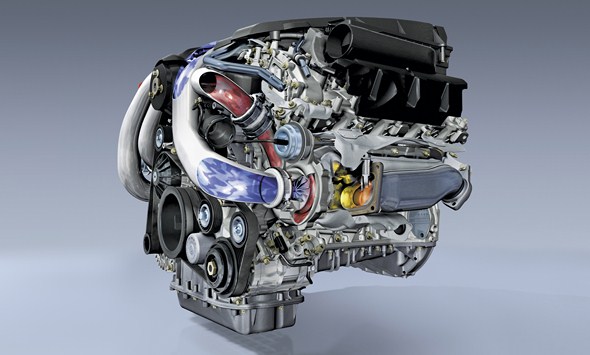
In the four-cylinder E 200 CDI BlueEFFICIENCY, E 220 CDI BlueEFFICIENCY, E 250 CDI BlueEFFICIENCY and E 200 BlueEFFICIENCY variants with a manual transmission, the engine is switched off as soon as the driver brakes, moves the shift lever to the neutral position and releases the clutch. It is restarted as soon as he operates the clutch.

In the E 250 BlueEFFICIENCY, E 350 BlueEFFICIENCY and E 500 BlueEFFICIENCY with the 7G-TRONIC PLUS automatic transmission as standard, the ECO start/stop function switches the engine off when the driver brakes the car to a stop and maintains pressure on the brake pedal. The engine restarts immediately when the driver takes his foot off the brake pedal.
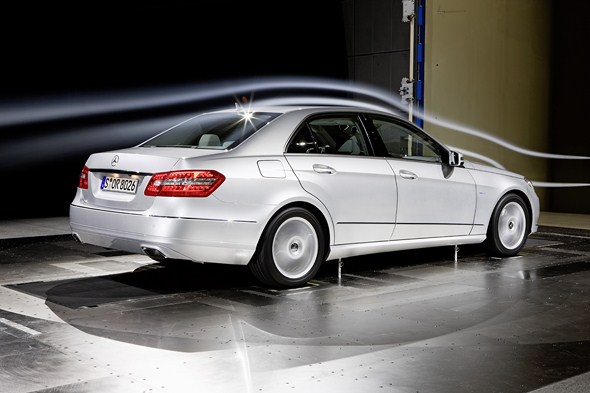
ECO start/stop function: high level of comfort and efficiency
Thanks to direct-start technology, the start/stop system developed for petrol engines by Mercedes-Benz works immediately and with low noise: when restarting, fuel is first injected into the cylinder whose piston is in the best possible starting position. The advantage is that after briefly turning the engine over, there is immediate ignition and combustion of the mixture in the best-positioned piston, which improves comfort while avoiding unnecessary fuel consumption and emissions.
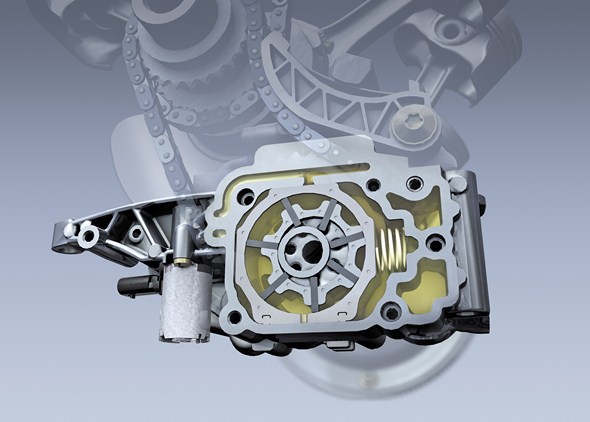
Thanks to intelligent control, the heating and entertainment systems remain operating during the stop phase for maximum comfort, as does the automatic climate control. The ECO start/stop function does not switch the engine off if the operating temperature required for proper emission control or the interior temperature desired by the driver have not yet been attained.
Comprehensively improved automatic transmission: 7G-TRONIC PLUS
In future the E-Class with automatic transmission will be equipped exclusively with 7G-TRONIC PLUS*. This comprehensively improved 7-speed automatic transmission is standard equipment in the E 250 BlueEFFICIENCY, E 350 BlueEFFICIENCY and E 500 BlueEFFICIENCY. One major feature of the latest evolutionary phase of 7G-TRONIC is a new generation torque converter with a much more dynamic response.
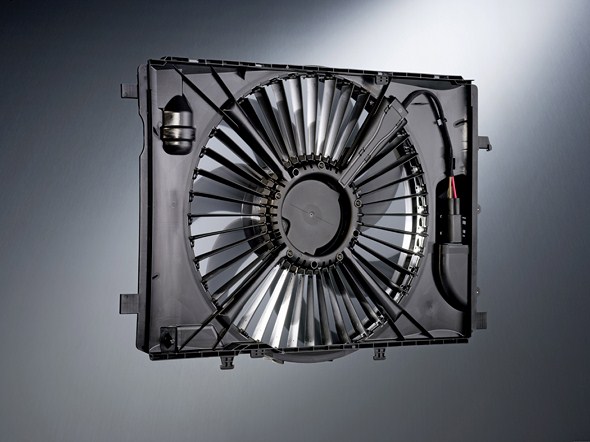
Noise and vibration levels have also been reduced thanks to a new hydraulic circuit, improved dampers and a new torque converter lock-up clutch with considerably reduced slip even under low loads. This has enabled Mercedes-Benz developers to lower engine speeds in the fuel-saving ECO transmission mode without compromising comfort.
With low-friction bearings and seals, as well as a new transmission fluid with lower viscosity, the transmission itself also contributes to fuel economy. Thanks to the long service life and unchanged cooling efficiency of the transmission fluid, this now only needs to be replaced every 125,000 kilometres. The transmission’s improved electro-hydraulic control unit and new, low-friction materials in various areas, as well as optimised software, lead to improved smoothness. Thanks to a separate, electrically driven transmission fluid pump, which is activated according to demand and allows comfortable, rapid starts, 7G-TRONIC PLUS is also start/stop-capable.
The four-cylinder diesels in the E-Class: considerable increase in efficiency
Particularly in the four-cylinder variants of the E-Class, the ECO start/stop function and 7G-TRONIC PLUS make for a considerable increase in efficiency. The engine specialists have also optimised the oil pressure control and belt drive, and equipped the turbocharger with a self-regulating compressor.
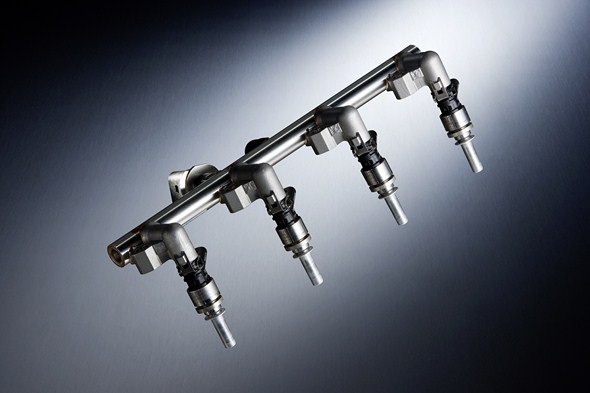
As a result of these extensive improvements, both the 6-speed manual and 7G-TRONIC variants of the 100 kW (136 hp) E 200 CDI BlueEFFICIENCY now have a combined NEDC fuel consumption of only 5.1-5.4 litres per 100 kilometres (134-141 g CO2/km). This is two percent (manual) and seven percent (automatic) less than before. In both transmission variants of the E 200 CDI BlueEFFICIENCY Estate, consumption and CO2 emissions have fallen to 5.3-5.6 l/100km and 140-147 g /km. This corresponds to a reduction by eight and 13 percent.
E 250 CDI BlueEFFICIENCY: the most efficient diesel in its class
In the E 220 CDI BlueEFFICIENCY with 125 kW (170 hp) and E 250 CDI BlueEFFICIENCY with 150 kW (204 hp) with the six-speed manual transmission, NEDC consumption and CO2 emissions have fallen by six percent to 5.0-5.3 l/100 km and 130-139 g/km. In the automatic versions they have fallen by as much as 16 percent to 4.9-5.3 l/100km and 129-138 g CO2/km. In the E 220 CDI BlueEFFICIENCY and E 250 CDI BlueEFFICIENCY Estate the reduction with the manual transmission is nine percent (5.2-5.4 l/100 km; 136‑141 g CO2/km), and with the automatic transmission 13 percent (5.3-5.5 l/100 km; 139-143 g CO2/km).
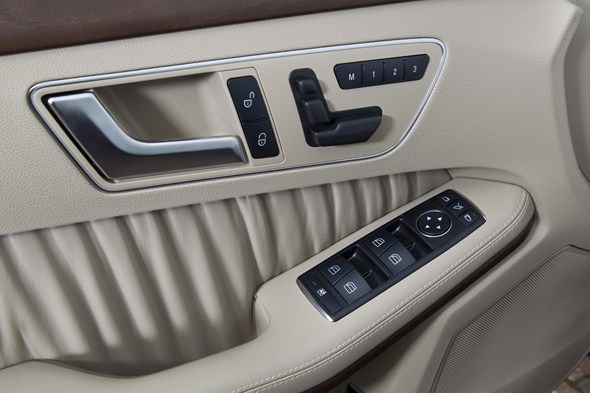
The outstanding fuel consumption figures of the E 250 CDI BlueEFFICIENCY make this model the most efficient diesel in its power category in the luxury class.
The all-wheel drive E 250 CDI 4MATIC BlueEFFICIENCY, which is available only with the 7G-TRONIC PLUS automatic transmission, also benefits from the efficiency-enhancing measures. With a combined fuel consumption of 5.6-5.8 l/100 km, this model requires eleven percent less fuel than before. CO2 emissions have fallen by the same, to 147-152 g/km.
The four-cylinder diesels in the E-Class at a glance*
| 200 CDI* BlueEFFICIENCY | E 220 CDI* BlueEFFICIENCY | E 250 CDI BlueEFFICIENCY | |
| Engine/cylinders | Diesel/4 in-line | Diesel/4 in-line | Diesel/4 in-line |
| Standard transmission | 6-speed manual | 6-speed manual | 6-speed manual |
| Displacement | 2143 cc | 2143 cc | 2143 cc |
| Rated output | 100 kW/136 hp | 125 kW/170 hp | 150 kW/204 hp |
| Rated torque | 360 Nm at 1600-2600 rpm | 400 Nm at 1400-2800 rpm | 500 Nm at 1600-1800 rpm |
| Fuel consumption of 2011 E-Class** | 5.1-5.4 l/100 km (M) 5.1-5.4 l/100 km (A) | 5.0-5.3 l/100 km (M) 4.9-5.3 l/100 km (A) | 5.0-5.3 l/100 km (M) 4.9-5.3 l/100 km (A) |
| Fuel consumption of preceding model** | 5.3-5.5 l/100 km (M) 5.5-5.9 l/100 km (A) | 5.3-5.5 l/100 km (M) 5.8-6.0 l/100 km (A) | 5.3-5.5 l/100 km (M) 5.8-6.0 l/100 km (A) |
| CO2 emissions of 2011 E-Class*** | 134-141 g/km (M) 134-141 g/km (A) | 130-139 g/km (M) 129-138 g/km (A) | 130-139 g/km (M) 129-138 g/km (A) |
| CO2 emissions of preceding model*** | 139-145 g/km (M) 145-153 g/km (A) | 139-144 g/km (M) 154-159 g/km (A) | 139-144 g/km (M) 154-159 g/km (A) |
*figures for Saloon; **NEDC combined fuel consumption; ***NEDC; M=manual transmission; A=automatic transmission
E 200 BlueEFFICIENCY and E 250 BlueEFFICIENCY: Exemplary efficiency
The comprehensive update to the powertrain has also brought significant fuel savings for the four-cylinder petrol engines. The E 200 BlueEFFICIENCY with 135 kW (184 hp), whose 6-speed manual version was previously the only variant of the E-Class to feature the ECO start/stop function, now also has this fuel-saving technology when equipped with 7G-TRONIC PLUS.
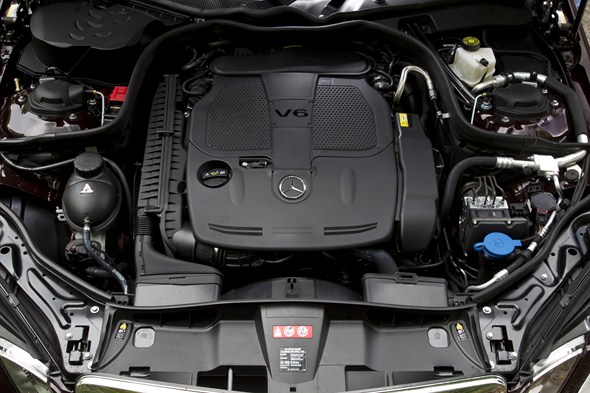
Together with the innovative power transmission this makes for a combined NEDC consumption of 6.5-6.9 litres of premium petrol per 100 kilometres (152-160 g CO2/km), 14 percent less than before. With a manual transmission the E 200 BlueEFFICIENCY Saloon now requires 2.5 percent less fuel (7.1-7.4 l/100 km; 169-176 g CO2/km).
The automatic version of the E 200 BlueEFFICIENCY Estate has a combined consumption of 6.8-7.0 l/100 km (159-163 g CO2/km). This is likewise a reduction of 14 percent. In the manual variant, fuel consumption and CO2 emissions are at the previous level of 7.7-7.8 l/100 km and 180-183 g/km.
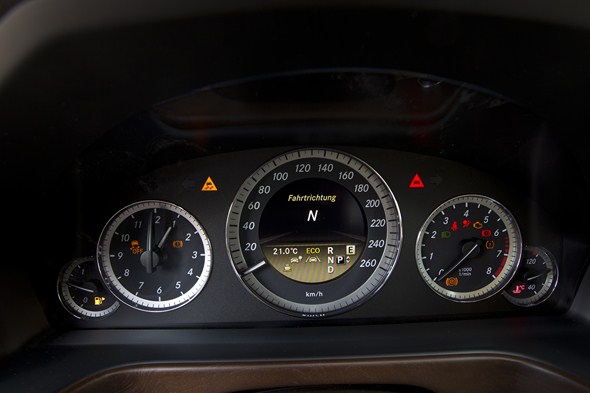
The exclusively 7G-TRONIC PLUS-equipped 150 kW (204 hp) E 250 BlueEFFICIENCY has a 13 percent lower fuel consumption of 6.6-7.0 l/100 km. CO2 emissions have fallen by the same, to 154-162 g/km. In the E 250 BlueEFFICIENCY Estate, fuel consumption and CO2 emissions of 6.8-7.0 l/100 km and 159-163 g/km are 15 percent lower than the figures for the preceding model with a 5-speed automatic transmission. This puts the E 250 BlueEFFICIENCY at the top of its class with respect to efficiency.
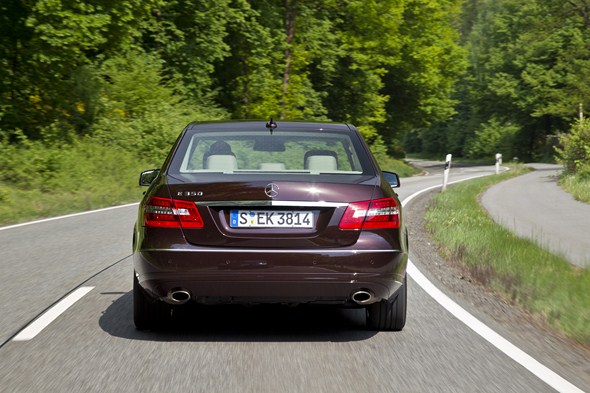
E 200 BlueEFFICIENCY and E 250 BlueEFFICIENCY at a glance*
| E 200 BlueEFFICIENCY | E 250 BlueEFFICIENCY | |
| Engine/cylinders | Petrol/4 in-line | Petrol/4 in-line |
| Standard transmission | 6-speed manual | 7-speed automatic |
| Displacement | 1796 cc | 1796 cc |
| Rated output | 135 kW/184 hp | 150 kW/204 hp |
| Rated torque | 270 Nm at 1800-4600 | 310 Nm at 2000-4300 |
| Fuel consumption of 2011 E-Class** | 7.1-7.4 l/100 km (M) 6.5-6.9 l/100 km (A) | 6.6-7.0/100 km (A) |
| Fuel consumption of preceding model** | 7.3-7.6 l/100 km (M) 7.5-7.9 l/100 km (A) | 7.6-8.0 l/100 km (A) |
| CO2 emissions of 2011 E-Class*** | 165-172 g/km (M) 152-160 g/km (A) | 154-162 g/km (A) |
| CO2 emissions of preceding model*** | 169-176 g/km 177-184 g/km | 179-187 g/km (A) |
*figures for Saloon; **NEDC combined fuel consumption; ***NEDC
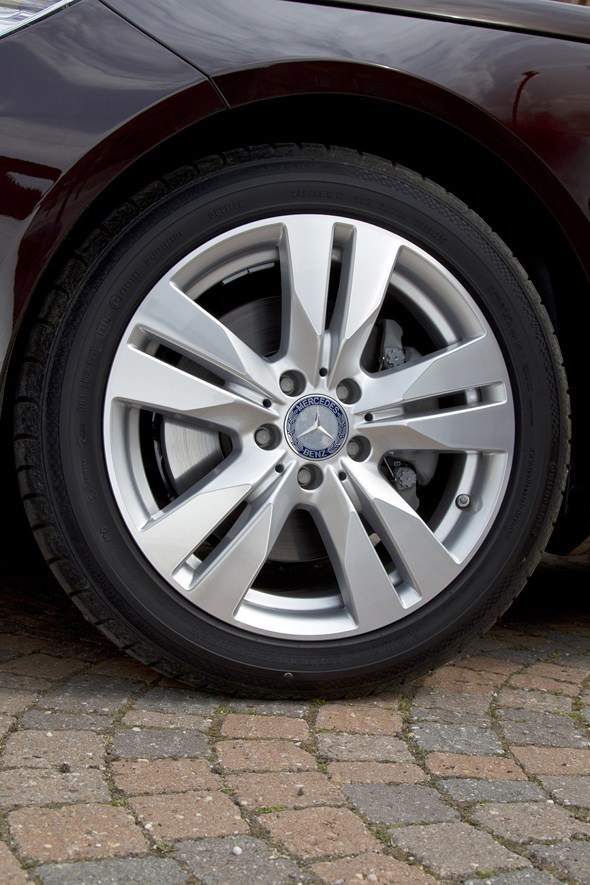
E 200 NGT BlueEFFICIENCY: luxury class with bivalent natural gas drive
The E 200 NGT BlueEFFICIENCY with bivalent natural gas drive rounds off the comprehensive update to the engine range for the Mercedes-Benz E-Class. The 120 kW (163 hp) four-cylinder in the Saloon can be operated on both premium petrol and natural gas.
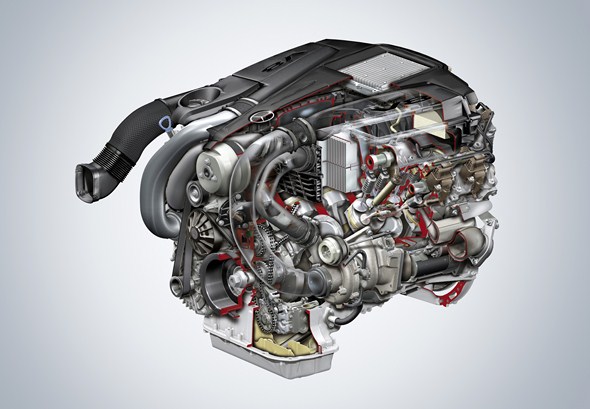
The advantage in natural gas mode is more than 20 percent lower CO2 emissions and considerably cleaner exhaust gases than with petrol or diesel fuel, as well as around 50 percent lower fuel costs compared to petrol operation. Operating range in natural gas mode is around 360 kilometres. Should the gas tank be empty, the vehicle automatically switches to petrol operation. This increases the range of the only bivalent natural gas model in the luxury class to over 1000 kilometres. The engine management system allows a smooth, jerk-free changeover from premium petrol to gas and vice versa at any time – also when on the move.
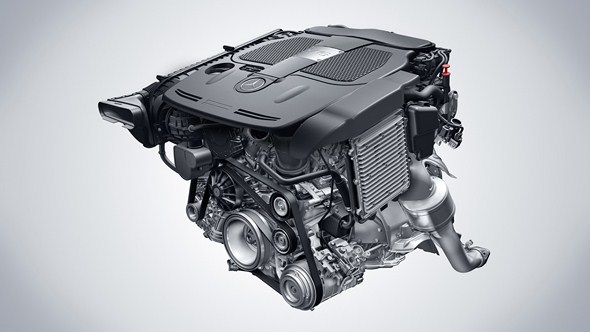
In addition to the petrol tank, three natural gas tanks are safely accommodated – one behind the rear seat backrest and two under the boot floor. They have a combined capacity of 121.5 litres of natural gas, corresponding to 19.5 kilograms. Compared to the preceding model, fuel consumption in petrol operation has been reduced by 13 percent to 8.1 litres per 100 kilometres (NEDC combined). In natural gas operation, the consumption of the E 200 NGT BlueEFFICIENCY has fallen by 0.6 kilograms to 5.5 kilograms per 100 kilometres. This corresponds to CO2 emissions of 149 grams per kilometre.
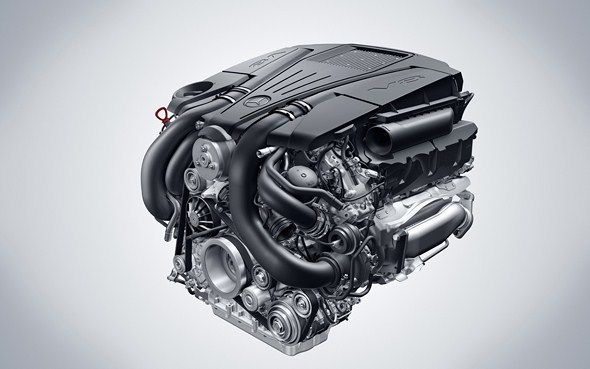
Comfort and design: perfected in detail
In addition to the new engine/powertrain features, the Mercedes-Benz E-Class now has new interior and exterior details. These include the full-colour TFT display in the instrument cluster, which is also capable of showing three-dimensional graphics. Another new feature is the standard DIRECT-SELECT selector lever for 7G-TRONIC PLUS on the steering column – also in the four-cylinder models.
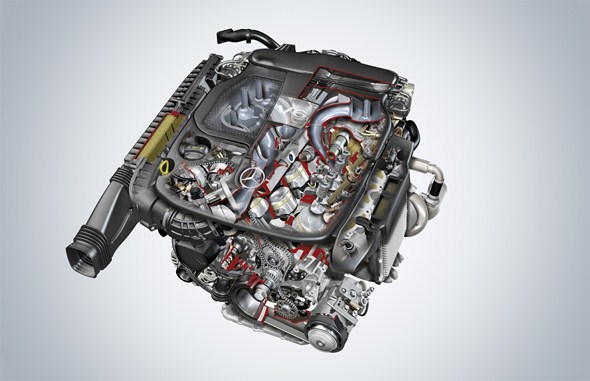
The driver is able to select transmission positions “P”, “N”, “R” and “D” by nudging a selector on the steering column. The operating commands are transmitted electronically, by cable. The package includes steering wheel gearshift paddles. Another standard feature in the ELEGANCE line is the luxury front head restraint, whose side bolsters can be adjusted as required.

